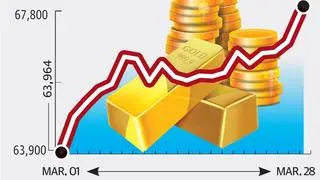The World Gold Council (WGC) released the full year demand trend of 2021 on Friday. The report shows that the total demand for gold went up by 10 per cent to 4,021 tonnes last year from 3,659 tonnes in 2020. The jump was mainly due to a 67 per cent increase in jewellery demand, which was recorded at 2,221 tonnes last year. Consumer demand turned towards gold jewellery as the global economies opened after the lockdown restrictions eased and there were no wild swings in price through the year.
On the other hand, the investment demand slumped by 43 per cent to 1,007 tonnes as the precious metal could not produce a rally which it saw in the preceding two years. This can be observed in gold ETF (Exchange Traded Funds) data. – global ETFs saw net outflow of about 173 tonnes in 2021 as against an inflow of 874 tonnes in 2020. Nevertheless, the demand for bars and coins were up by 31 per cent to 1,180 tonnes – the highest in the last eight years. Central banks added 463 tonnes to their reserves in 2021, an 82 per cent increase from the previous year. Overall, the jewellery and central banks were the biggest sources of demand for the yellow metal in 2021.
Notably, both jewellery and investment demand saw considerable increase in the final quarter of calendar year 2021, boosting the overall demand for the year. The demand in the final quarter was at 713 tonnes (47 per cent increase year-on-year) was the highest since second quarter of 2013. The investment demand more than doubled to 300 tonnes in 2021 compared to 138 tonnes in the corresponding quarter of 2020.
India trend and Fed effect
The total demand for the precious metal in India last year was up by 79 per cent to 797 tonnes versus 446 tonnes in 2020. Jewellery, the largest driver, saw its demand almost doubling to 611 tonnes (six year high) compared to 316 tonnes in the preceding year. Investment demand too increased by 43 per cent, unlike the global trend, to 187 tonnes as against 130 tonnes in 2020.
For 2022, the WGC expects the demand recovery to continue, although not at the pace seen in the last quarter of 2021. Factors to watch would be COVID-19 and its variants, inflation, interest rate and geo-political developments.
While the WGC data gives us the long-term picture, the hawkish tone from the Fed hammered the bullion last week. Bullion prices are adjusting to the end of asset purchases and the beginning of interest rates upcycle. Last week, gold and silver lost 2.3 and 7.2 per cent in the international spot market and ended at $1,791.7 and $22.48 per ounce, respectively. Similarly, on the Multi Commodity Exchange (MCX), gold futures (April expiry) lost 1.4 per cent and closed at ₹47,585 (per 10 grams); silver futures (March series) was down by 5.8 per cent as it ended at ₹61,034 (per kg).
MCX-Gold (₹47,585)
On Tuesday last week, the April futures of gold on the MCX, by ending the day at ₹48,968, closed above the resistance at ₹48,550 and the prior high of ₹48,916. This appeared as if the field is set for the bulls to take over and lift the contract to higher levels. But, there was a complete change in the scenario as there was a sudden wave of selling. This not only dragged the contract below the important level of ₹48,550, but also overturned the bullish inclination which was slowly building up over the preceding two weeks.
Since the futures closed at ₹47,585, it essentially remains within the range of ₹47,400 – ₹48,550. So, even though the price action is indicating a strong downward momentum, the support at ₹47,400 can be a breather for the bulls. Hence, as it stands, refrain from trading and initiate shorts only if the contract decisively breaks below ₹47,400.
A breach of ₹47,400 can turn the near-term outlook negative wherein the contract can fall to ₹46,800 and ₹45,920 quickly. Alternatively, a recovery from the current levels will meet with resistance at ₹48,100 and ₹48,550.
MCX-Silver (₹61,034)
Silver was under downward pressure all through the week as market participants continued to sell. Consequently, the March silver futures on the MCX declined sharply and fell below the key supports at ₹64,000 and ₹62,500. Thus, the long positions that we recommended at around ₹64,800 and ₹63,400 hit the stop-loss at ₹62,300.
The prevailing price action indicates a strong bearish bias. However, from the current level of ₹61,034, the contract has a solid base at ₹60,000. Below this level, ₹58,700 is a support. So, until at least ₹60,000 is broken, traders are advised to stay away from trading. A recovery beyond ₹62,500 this week looks less likely. Both 21- and 50-day moving averages coincide at this level making it a significant barrier. Above this, ₹64,000 can be a resistance.
Keep a close watch on ₹60,000 as a breach of this level can potentially turn the near-term outlook negative, giving us the opportunity to take fresh shorts.








Comments
Comments have to be in English, and in full sentences. They cannot be abusive or personal. Please abide by our community guidelines for posting your comments.
We have migrated to a new commenting platform. If you are already a registered user of TheHindu Businessline and logged in, you may continue to engage with our articles. If you do not have an account please register and login to post comments. Users can access their older comments by logging into their accounts on Vuukle.